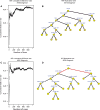Ensemble survival tree models to reveal pairwise interactions of variables with time-to-events outcomes in low-dimensional setting
- PMID: 29453930
- PMCID: PMC5844232
- DOI: 10.1515/sagmb-2017-0038
Ensemble survival tree models to reveal pairwise interactions of variables with time-to-events outcomes in low-dimensional setting
Abstract
Unraveling interactions among variables such as genetic, clinical, demographic and environmental factors is essential to understand the development of common and complex diseases. To increase the power to detect such variables interactions associated with clinical time-to-events outcomes, we borrowed established concepts from random survival forest (RSF) models. We introduce a novel RSF-based pairwise interaction estimator and derive a randomization method with bootstrap confidence intervals for inferring interaction significance. Using various linear and nonlinear time-to-events survival models in simulation studies, we first show the efficiency of our approach: true pairwise interaction-effects between variables are uncovered, while they may not be accompanied with their corresponding main-effects, and may not be detected by standard semi-parametric regression modeling and test statistics used in survival analysis. Moreover, using a RSF-based cross-validation scheme for generating prediction estimators, we show that informative predictors may be inferred. We applied our approach to an HIV cohort study recording key host gene polymorphisms and their association with HIV change of tropism or AIDS progression. Altogether, this shows how linear or nonlinear pairwise statistical interactions of variables may be efficiently detected with a predictive value in observational studies with time-to-event outcomes.
Keywords: epistasis; genetic variations interactions; interaction detection and modeling; random survival forest; time-to-event analysis.
Conflict of interest statement
Figures




Similar articles
-
Individual risk prediction: Comparing random forests with Cox proportional-hazards model by a simulation study.Biom J. 2023 Aug;65(6):e2100380. doi: 10.1002/bimj.202100380. Epub 2022 Sep 28. Biom J. 2023. PMID: 36169048
-
No Evidence for Association of β-Defensin Genomic Copy Number with HIV Susceptibility, HIV Load during Clinical Latency, or Progression to AIDS.Ann Hum Genet. 2017 Jan;81(1):27-34. doi: 10.1111/ahg.12182. Ann Hum Genet. 2017. PMID: 28084001
-
A prognostic model for estimating the time to virologic failure in HIV-1 infected patients undergoing a new combination antiretroviral therapy regimen.BMC Med Inform Decis Mak. 2011 Jun 14;11:40. doi: 10.1186/1472-6947-11-40. BMC Med Inform Decis Mak. 2011. PMID: 21672248 Free PMC article.
-
Defensin gene variation and HIV/AIDS: a comprehensive perspective needed.J Leukoc Biol. 2016 May;99(5):687-92. doi: 10.1189/jlb.6RU1215-560R. Epub 2016 Mar 8. J Leukoc Biol. 2016. PMID: 26957215 Free PMC article. Review.
-
The effect of genetic variation in chemokines and their receptors on HIV transmission and progression to AIDS.Immunol Rev. 2000 Oct;177:99-111. doi: 10.1034/j.1600-065x.2000.17710.x. Immunol Rev. 2000. PMID: 11138790 Review.
Cited by
-
Deep-learning survival analysis for patients with calcific aortic valve disease undergoing valve replacement.Sci Rep. 2024 May 13;14(1):10902. doi: 10.1038/s41598-024-61685-0. Sci Rep. 2024. PMID: 38740898 Free PMC article.
References
-
- Breiman L. Random forests. Mach. Learn. 2001;45:5–32.
Publication types
MeSH terms
Substances
Grants and funding
LinkOut - more resources
Full Text Sources
Other Literature Sources
Medical
Molecular Biology Databases
